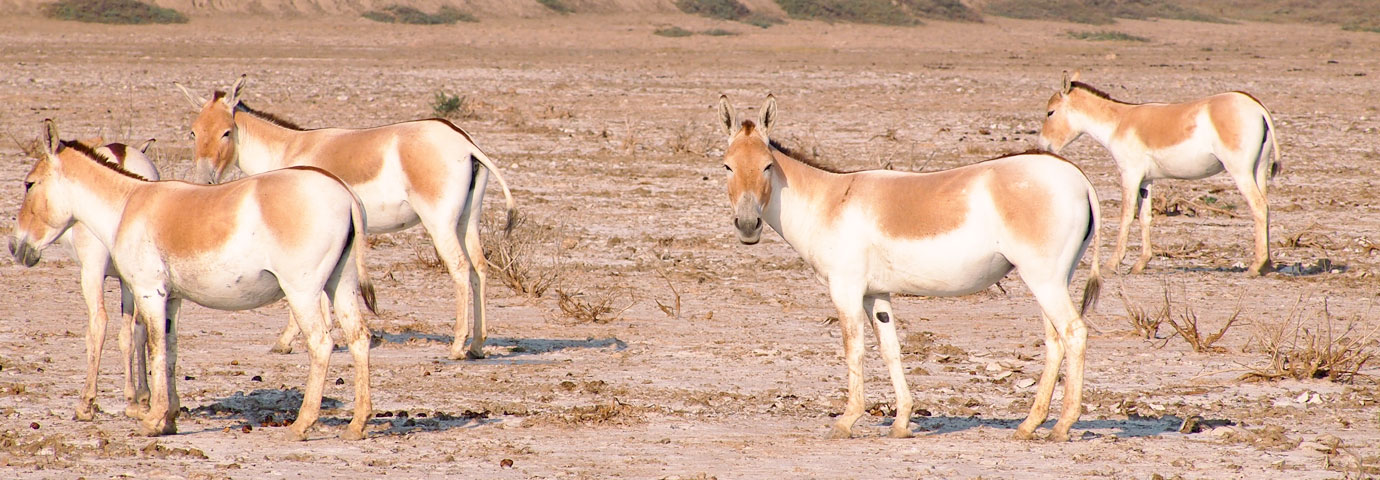Fast Facts
|
Area
|
495, 370 hectares
|
|
Altitude
|
2 to 3 m above sea level
|
|
Language |
Gujarati, Hindi, and English |
|
Best time to visit |
October to June |
A safari through the Indian Wild Ass Sanctuary in the Little Rann of Kutch in northwest Gujarat is a unique experience. A safari through this region gives one a chance to come face to face with a wide variety of birds and other wildlife.
Location
Situated in the region of the Little Rann of Kutch in Gujarat, the sanctuary is around 150 km off Ahmedabad. The sanctuary lies between the latitude 23.26° North and longitude 71.20° East. The region is well connected to other parts of the state through regular road transport.
Best Time To Visit
The climate of the region is extreme with May being the hottest month. The average temperature during this time is around 31°C. January is the coldest month with an average temperature of 11°C. During the monsoon, the whole region becomes flooded with rainwater.
Flora And Fauna
The Rann of Kutch is full of dry thorny scrub and there are no large trees. The main vegetation in the region includes many species of grasses that are widely available as the source of food for the wild Asses.
The most famous wildlife of the region includes the Indian Wild Ass, as well as the chinkara, desert fox, jackal, desert cat, caracal, nilgai, wolf, blackbuck, and striped hyena.
Tourists Attractions
The Little Rann of Kutch, which covers an area of roughly 5,000 square km, is primarily known as the Indian Wild Ass Sanctuary. The sanctuary was established in 1972 as the last natural habitat of the Indian Wild Ass (Equus Hemionus Khur). One of the three surviving species of the Wild Ass in the world-the other two being found in Central Asia and in and around Tibet-the Khur is high on the list of endangered species. Only 1,800 to 2,000 of the species survive today.
Besides the Wild Ass, the sanctuary is home to a host of other animals and nearly 350 different species of birds, including the common crane, pelican and the lesser flamingo. Apart from this, one can also get a rare insight into the lifestyles of the numerous ethnic groups and local tribes, which live in and around the Rann. The tribes living in the region are the Kolis, Rabaris, Bajanias, Kutchis, Gujjars and the Bharvads.
Interestingly, the Little Rann gets a fair number of winged visitors in the winter months. Among these, the blue-tailed bee-eater that comes all the way from Europe; the common crane and the demoiselle crane from Siberia; the ceraneous vulture from Egypt and the houbara bustard from Iran and Iraq are the ones most commonly sighted.
Zinjuwada, bang on the edge of the Rann, has an old, 11th century fort built during the Solanki era and houses one of the area's largest salt works.
Zainabad, 150 km off Ahmedabad, is the ideal base for a trip into the sanctuary. Zainabad had been founded in the early part of this century. The ruling family of this place came here from Multan around the mid-13th century to settle down in Dasada. It was only around 1912 that the capital was shifted to a village called Karala, which was later renamed Zainabad.
Places Around Wild Ass Sanctuary
Rajkot is an important city in the Saurashtra region. The place was formerly the capital of this region and is famous for its Association with Mahatma Gandhi.
Modhera is famous for its temples built of delicately carved stone.
Patan is one of the oldest cultural centers in the region and famous for its Patola saris.
There are some other national parks in the region including the Marine National Park and Nal Sarovar Park, which are rich in flora and fauna and are really worth a visit.
The other important places in the vicinity of the Little Rann of Kutch are Bhuj and Wankaner.
How To Reach
By Air - Bhuj, situated around 150 km is the nearest airport. There are regular flights to Mumbai from Bhuj.
By Rail - Dhangadhra situated around 22 km from the sanctuary and 130 km from Ahmedabad is the nearest railway station. The place is connected to all the major cities in the region.
By Road - The sanctuary is well connected to the other important places in the state by State Transport Corporation buses as well as luxury coaches operated by private companies. From Bhuj, regular buses, auto-rickshaws, and taxis are available for commuting up to the sanctuary and there are direct buses from Rajkot too. From Ahmedabad, one can take a bus to Dasada, 12 km northeast of Zainabad, the nearest important place to sanctuary.


